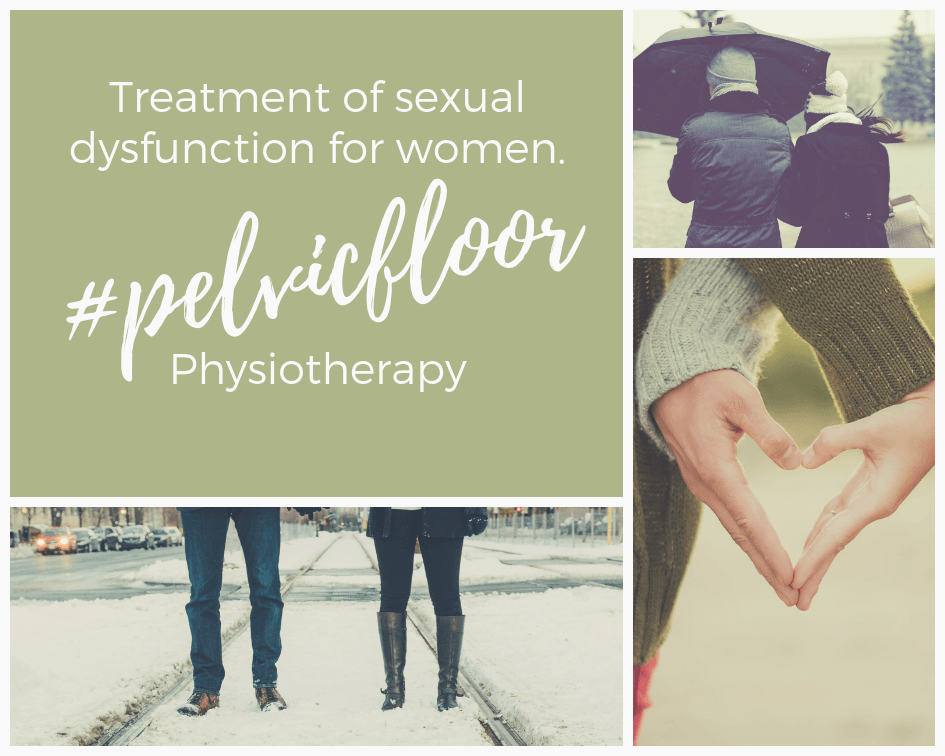
This blog is a follow up to last month’s blog about sexual dysfunction in women, except that I want to focus on how you can improve your sex life with physiotherapy.
Sexual pain can be caused by a number of different factors. Speaking with your doctor is always advised and seeing a pelvic floor physiotherapist.
Women Postpartum
In the case of new moms, most often the pain is due to perineal trauma from tears or episiotomies. When the perineum heals, it lays down scar tissue and this tissue is different from healthy tissue. It is often tighter and more sensitive to compression and stretch. We have receptors in the tissue that alerts the brain anytime there is compression or stretch that may be potentially dangerous and often times the resulting feeling is pain, stabbing, burning, needles, pin pricks or other unpleasant symptoms.
As a physiotherapist I assess this tissue to determine the quality of movement of the tissue, its ability to stretch and its level of sensitivity. Based on the assessment I will teach you stretching and massage techniques to help soften the scar tissue and de-sensitize the area.
You may be wondering if treatment is painful? Yes you may experience discomfort with the treatment and it is always something we are monitoring for during the session. The technique for releasing the scar tissue that I teach is designed to reduce the amount of discomfort so you can actually be successful in releasing the tension. I give very specific instructions to ensure the tissue stays within a safe stretch. With manual stretching techniques I also teach women to relax the pelvic floor. Often times, women will report tensing in anticipation that it will hurt to have sex and then in fact it does hurt.
We need to teach the body to relax and we do that by learning to breathe and lots of education about what pain is which allows you to feel more confident in the exercises and homework. Also, you may not be aware of this but postpartum you could also be experiencing dryness because of the changes in the hormones. So we have some discussions around options of what you can do for that.
For most women postpartum it’s about working on the first 1/3 of the vaginal opening, but sometimes we need to release tension deeper in the pelvic floor and that’s why a comprehensive assessment by a trained pelvic floor physiotherapist is advised.
Women with no children
Sexual dysfunction in women who have never been pregnant can also be present for a number of different reasons. A common reason is pain or inability to penetrate. Our treatment approach most often involves the use of dilators. Dilators are plastic or silicone tube like items that comes in varying sizes starting from the smallest, that is thinner than a tampon to eventually reaching the size of a large penis.
The approach is to teach women how to insert and work with the dilators to progressively stretch the tissues so they eventually can have penetration and/or no pain with penetration. There are a few things that come with working with dilators. It is not something we just jump into. Most often I need to teach relaxation breathing techniques, mindfulness techniques, stretches and lots of pain education so the client can understand what they feel and why they are doing this technique.
Sexual Dysfunction in Menopause
Women in the peri/post menopausal stage experience sexual dysfunction as a result of changes in the tissues whether muscle tightness, muscle weakness or stiffness. When women begin to lose estrogen the tissues can become stiffer, less mobile and there can also be thinning of the walls. Often times a multi-disciplinary approach is needed where localized hormones are used which would be guided by your doctor or naturopathic doctor in combination with physiotherapy.
From a physiotherapy perspective, my job is to help your fascia/muscles move more easily and stretch. This requires good breathing techniques, body awareness, releasing/relaxing fascia and sometimes strengthening the pelvic floor. Strengthening only comes after you have regained mobility in the tissues of the pelvic floor and no tension is present. Stronger muscles help absorb the energy and cushion the thrust.
Each woman is unique, with her own challenges. It is important when designing any treatment plan to understand what is happening, what the thoughts/feelings associated with what is happening and finding the best route to get you back on track to enjoying sex. So don’t be surprised if the physiotherapist asks lots of questions.
These are the common approaches to sexual dysfunction but other approaches may be required. So if you are wondering if I can help your particular situation, please reach out to me and I would be happy to discuss and answer your questions.
Don’t suffer in silence and don’t think that no one will understand. I see patients all the time with different sexual challenges. It’s a daily conversation for me, so please reach out.
 Written By: Madelaine Golec PT, Pelvic Health Physiotherapist
Written By: Madelaine Golec PT, Pelvic Health Physiotherapist
